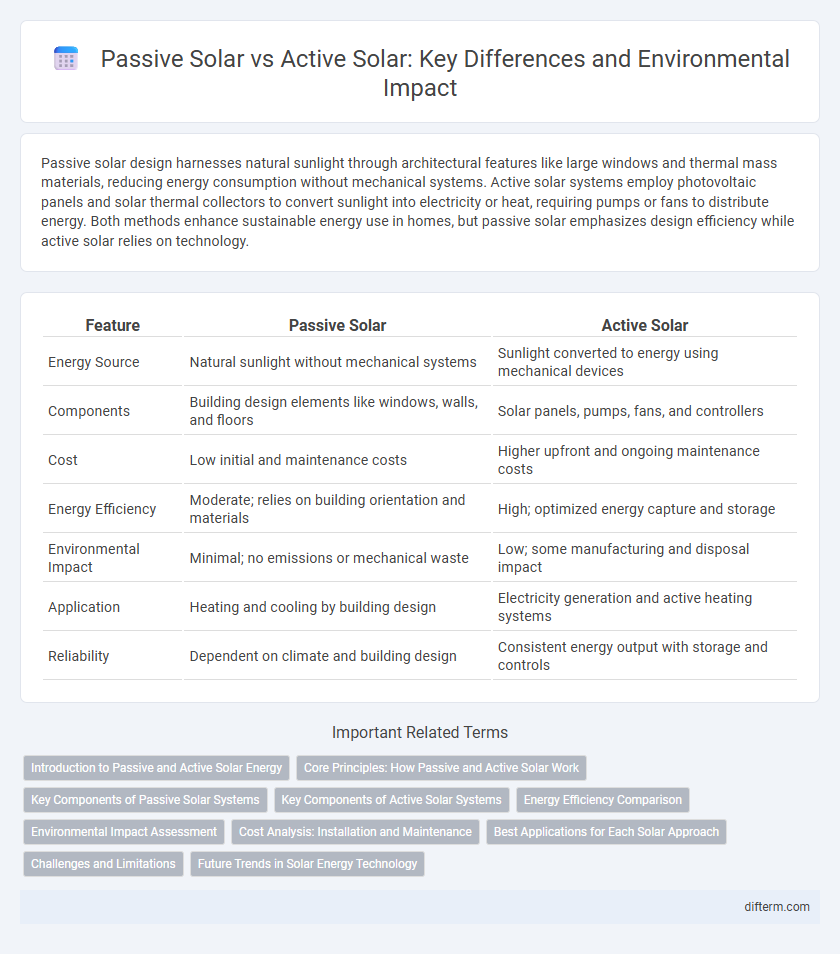Passive solar design harnesses natural sunlight through architectural features like large windows and thermal mass materials, reducing energy consumption without mechanical systems. Active solar systems employ photovoltaic panels and solar thermal collectors to convert sunlight into electricity or heat, requiring pumps or fans to distribute energy. Both methods enhance sustainable energy use in homes, but passive solar emphasizes design efficiency while active solar relies on technology.
Table of Comparison
| Feature | Passive Solar | Active Solar |
|---|---|---|
| Energy Source | Natural sunlight without mechanical systems | Sunlight converted to energy using mechanical devices |
| Components | Building design elements like windows, walls, and floors | Solar panels, pumps, fans, and controllers |
| Cost | Low initial and maintenance costs | Higher upfront and ongoing maintenance costs |
| Energy Efficiency | Moderate; relies on building orientation and materials | High; optimized energy capture and storage |
| Environmental Impact | Minimal; no emissions or mechanical waste | Low; some manufacturing and disposal impact |
| Application | Heating and cooling by building design | Electricity generation and active heating systems |
| Reliability | Dependent on climate and building design | Consistent energy output with storage and controls |
Introduction to Passive and Active Solar Energy
Passive solar energy harnesses sunlight by designing buildings to naturally collect, store, and distribute solar heat without mechanical systems, utilizing materials like concrete and glass for thermal mass. Active solar energy relies on mechanical devices such as solar panels, pumps, and fans to capture, convert, and distribute solar power for heating or electricity generation. Understanding the distinction between passive and active solar systems is crucial for optimizing energy efficiency and reducing environmental impact in sustainable architecture.
Core Principles: How Passive and Active Solar Work
Passive solar design harnesses sunlight through strategic building orientation, materials, and architectural features to naturally regulate indoor temperature without mechanical systems. Active solar systems use photovoltaic panels or solar collectors combined with mechanical devices such as pumps and fans to convert sunlight into electricity or heat for immediate use or storage. Both approaches maximize solar energy utilization, with passive solar emphasizing energy conservation through design efficiency and active solar focusing on energy generation via technology.
Key Components of Passive Solar Systems
Key components of passive solar systems include south-facing windows designed to maximize solar heat gain, thermal mass materials such as concrete or brick that absorb and store heat, and effective insulation to reduce heat loss. These elements work together to naturally regulate indoor temperatures without mechanical assistance. Unlike active solar systems, passive solar relies on building design and materials to harness and retain solar energy efficiently.
Key Components of Active Solar Systems
Active solar systems utilize key components such as solar panels, pumps, and heat exchangers to capture and distribute solar energy efficiently. These systems rely on mechanical devices like circulator pumps and controllers to move heat from solar collectors to storage tanks or directly into buildings. The integration of thermal storage tanks and heat transfer fluids enhances energy retention and allows for consistent indoor temperature regulation.
Energy Efficiency Comparison
Passive solar designs enhance energy efficiency by utilizing building orientation, materials, and natural ventilation to reduce heating and cooling demands without mechanical systems. Active solar systems employ photovoltaic panels or solar thermal collectors paired with pumps or fans to actively convert sunlight into usable energy, often resulting in higher initial efficiency but requiring maintenance and energy input. Comparing both, passive solar is more sustainable with lower operational costs, while active solar typically delivers greater and more controllable energy output, especially in varied climatic conditions.
Environmental Impact Assessment
Passive solar design reduces environmental impact by utilizing building orientation and materials to absorb and store solar energy without mechanical devices, minimizing energy consumption and carbon emissions. Active solar systems involve photovoltaic panels or solar thermal collectors that require manufacturing, maintenance, and energy input, which can contribute to environmental footprints through resource extraction and waste generation. Environmental Impact Assessments of both systems consider lifecycle emissions, resource use, and ecological disruption, often favoring passive solar strategies for sustainable building practices.
Cost Analysis: Installation and Maintenance
Passive solar systems typically have lower installation costs due to their reliance on building design elements like windows and thermal mass, requiring minimal mechanical components. Active solar systems involve higher initial expenses because of the need for photovoltaic panels, pumps, and controllers, alongside more frequent maintenance to ensure system efficiency. Long-term maintenance costs for active systems include occasional component replacements and monitoring, whereas passive systems generally incur minimal upkeep expenses.
Best Applications for Each Solar Approach
Passive solar design excels in residential buildings with ample south-facing windows, where natural heat gain and daylighting reduce energy consumption without mechanical systems. Active solar systems are ideal for commercial and industrial applications requiring high energy output, utilizing photovoltaic panels or solar thermal collectors with pumps or fans to distribute energy. Urban areas with limited sunlight exposure benefit more from active solar installations, as they can adjust to varying conditions for optimized energy capture.
Challenges and Limitations
Passive solar systems face challenges such as limited control over heat distribution and dependency on building design and orientation, which can reduce efficiency in certain climates. Active solar systems require mechanical components like pumps and fans, leading to higher upfront costs, maintenance needs, and energy consumption that can offset some environmental benefits. Both systems may struggle with energy storage and inconsistency during periods of low sunlight, hindering reliable continuous power supply.
Future Trends in Solar Energy Technology
Future trends in solar energy technology emphasize the integration of hybrid systems combining passive solar design with advanced active solar components to maximize energy efficiency. Innovations in materials, such as phase-change materials for passive heat regulation and high-efficiency photovoltaic cells, are enhancing the performance of solar installations. Smart grid technology and energy storage advancements further drive the adoption of both passive and active solar solutions for sustainable, resilient energy systems.
passive solar vs active solar Infographic

 difterm.com
difterm.com